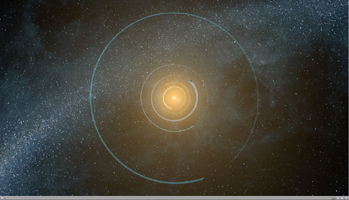An Unusual Planetary System (Artist's Concept)

Click on the image for the video
This artist's animation flies through the Kepler-20 star system, where NASA's Kepler mission discovered the first Earth-size planets around a star beyond our own. The system is jam-packed with five planets, all circling within a distance roughly equivalent to Mercury's orbit in our solar system.
The two Earth-size planets, which are presumably rocky, are Kepler-20e and Kepler-20f, and the three larger gas planets are Kepler-20b, Kepler-20c and Kepler-20d. The arrangement of the planets from the closest to its star to the farthest is: b, e, c, f and d, with the ordering of the letters reflecting the time at which the planets were initially discovered.
This animation begins by showing the farthest planet from the star, Kepler-20d, then flies over to Kepler-20f and moves on successively to closer and closer planets. It then pans out to show all five planets in the miniature solar system.
The Kepler-20 system is unusual in that the sizes of the planets alternate, with the closest in being large, followed by a small planet, and then continuing on with the planets switching back and forth in size. Astronomers are intrigued by this configuration because it completely differs from that of our solar system, where there is a clear separation between the four small, rocky inner planets, and the four giant, gaseous outer planets.
NASA's Ames Research Center in Moffett Field, Calif., manages Kepler's ground system development, mission operations and science data analysis. JPL managed the Kepler mission's development.
For more information about the Kepler mission and to view the digital press kit, visit http://www.nasa.gov/kepler.
